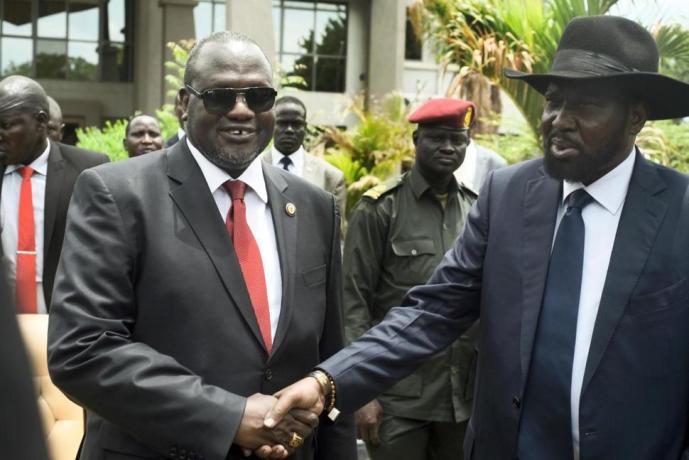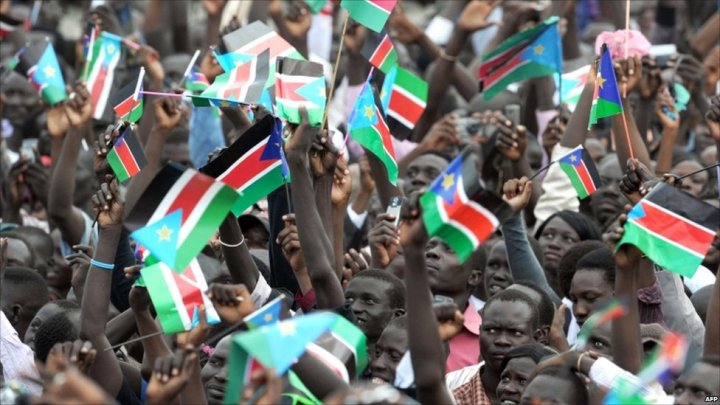The Transitional Government of South Sudan
“My brother is in Juba” – From Civil War to Reconciliation
The Transitional Government
On April 26th Riek Macher returned to Juba and was sworn in as vice president, a condition of the peace agreement signed in August of last year. Upon his return, both Macher and Salva Kiir appealed to the international community for aid, and The World Bank has stated it has 230 million dollars worth of projects to implement once the formation of the Transitional Government of South Sudan is complete. South Sudan’s leading donors, the US, UK, and Norway, have stated any funding remains contingent on the new government carrying out the peace deal.
As Salva and Riek settle into Juba together, advocates are calling out for food security to be at the top of the agenda. The World Food Program is warning that “more than five million people may go hungry in South Sudan.” USAID is partnering with the WFP and at the fore front of supplying assistance to South Sudan in this crisis. Even though the aid income is a helpful step in addressing this deep need, alone isn’t enough.
The people in South Sudan need physical security, something that is deeply linked to conflict transformation, a peace that runs in hearts and souls, not just in the ink of peace agreements. This week, South Sudanese church leader, Paulino Lokudu Loro, called all the tribes of South Sudan to examine their “togetherness.” Riek and Salva, the center of the Transitional Government of South Sudan, have the power to lead the nation into unity and out of devastating violence. In this way South Sudan needs a Transformational Government.
Before the Transitional Government
A review of South Sudan in War and Peace
On July 9th, 2011, the world’s newest country was created. Located in East-Central Africa, The Republic of South Sudan, more commonly referred to as South Sudan, became the world’s 193rd nation. But in order to understand how this came about, one must look back in its history, starting in 1956.
Under British rule until 1956, the country of South Sudan finally gained its independence in 2011, with the agreement that the southerners would be able to take part in the political system. This understanding failed to occur because of the divide between the north and south. The two parts of the country are very different, with the north consisting of Arabs and Muslims, while the south is comprised of Africans who are Christian or Animist. Once the Khartoum government backtracked on its promises, a rebellion began that led to two periods of conflict. The first took place between 1955 and 1972. The second began in 1983 and lasted until 2005. Over two million people died during these conflicts, mainly from starvation and drought.
After numerous peace talks, the Comprehensive Peace Agreement came to fruition and was signed in 2005. This agreement stipulated that the South would be granted a six-year period of autonomy, which would be followed by a vote on its final status. In January 2011, with a 98% vote for secession, the South officially separated from the North. Since gaining this independence in July of 2011, South Sudan has struggled to build its nation and maintain its government. In December of 2013 civil war between the two major tribes, the Dinka and the Nuer, began to ravage the country to point where civilians continue to die or flee the country.
In this new civil war, over 50,000 people have been killed with an additional 1.6 million being displaced. The two main factions of the civil war consist of the government’s Sudan People’s Liberation Army (SPLA) and the Sudan People’s Liberation Movement-in Opposition (SPLM-IO), with the former under the control of current president Salva Kiir and the latter being under the command of former vice-president Riek Macher. The war initially started over a power struggle between Kiir and Machar, which led to violence between presidential guards. Soldiers from the Dinka ethnic group aligned with President Kiir and those from the Nuer ethnic group chose to side with Riek Macher. Numerous atrocities have been committed by armed groups, including rape and sexual violence, destroying property and looting, and killing civilians from different ethnic lines. The violence has also prevented farmers from planting and harvesting crops, which led to the United Nations Security Council calling the South Sudan’s food crisis the worst in the world.
After initial peace talks between the two parties failed to bring about any significant changes, a proposed formation for a transitional government was agreed upon earlier this year (2016). Amid concerns of the worsening situation in South Sudan, The Transitional Government of National Unity (TgoNU) is intended to be established in Juba in the Spring of 2016. There has been much optimism behind the TgoNU, and many individuals, including the Chief Negotiator for the SPLM/A in Opposition, Taban Deng Gai, have expressed positive enthusiasm toward negotiations between the two parties.
Sometimes, it’s hard to fathom peace in a country where bones of the dead lay ripe for feral animals to pick at. Nicholas Kristof, a prominent journalist for the New York Times, has referred to the area outside of Leer as “The Killing Field.” If the Transitional Government of South Sudan does bring about an end to the situation in South Sudan, people will be able to obtain the food they need, the education they desire, and the peace they deserve.








